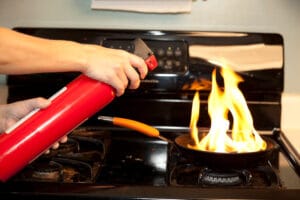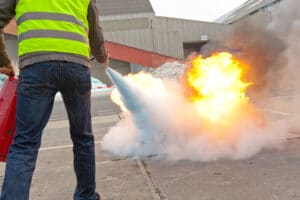
The fire extinguisher is one of the most common safety tools you can own and a critical first line of defense against fires in the home or workplace. But it’s important to understand that, while you may have a fire extinguisher (or several) at hand, having the right fire extinguisher is what matters most. Not all fires are created equal and having the extinguisher that meets the needs of your unique risks means understanding the five classifications of fires so you can be prepared to battle them effectively when, and if, they happen at your home or business.
The Class A
The Class A fire uses common flammable materials such as wood, trash, paper and plastics as its fuel source. These are often the accidental type of fires that occur across several industry types and ones commonly extinguished with water or monoammonium phosphate.
The Class B

Liquid or gas fueled fires from sources like petroleum based oils and paints, gasoline or kerosene, or gasses such as butane or propane are common hazards in industries that use and store fuels, lubricants and certain types of paint. To safely extinguish these Class B fires, smothering them to remove oxygen or using chemical reactions that produce similar smothering effects can be most effective.
The Class C
Any fire that uses electrical components or energized equipment as its fuel source – such as motors, appliances and electronic transformers – is a Class C fire most common in industries that deal with energy or use heavy electrically-powered equipment. These fires can also occur on a smaller scale in businesses and homes from faulty wiring and overloaded surge protectors. If a Class C fire breaks out in your business or home, cut the power as quickly as possible and use non-conductive chemicals to extinguish the flames safely.
The Class D

Class D fires use combustible metals as their source such as titanium, aluminum, potassium and magnesium. For laboratories and any industry that uses combustible metals as part of the production process, Class D fires are certainly a danger and the use of common extinguishing agents like water are ineffective and can actually be hazardous. Instead, choose a dry powder agent to smother the flames and absorb the heat the fire needs to continue burning.
The Class K
Technically a type of liquid fire, Class K fires are defined as cooking fires that involve the combustion of liquids used in food preparation and are unique enough to warrant their own classification. These intense fires are fueled by cooking materials such as grease, cooking oil, vegetable fat and animal fat, and are major concerns for food service and restaurant industry businesses. Safely extinguishing these dangerous and destructive fires requires a wet chemical fire extinguisher. Never attempt to extinguish a grease fire with water.

Having the right fire extinguisher for your unique risks is an important part of your home or office safety plan. For businesses, this can often mean having multiple extinguishers on hand to effectively battle fires that may occur in various areas of the building – from the office spaces to the production floor. Keep yourself, your employees and your guests and visitors safe with the right extinguishers for your needs.
Always be certain your extinguishers are in working order and everyone knows the most effective way to use them should an accident or emergency occur.